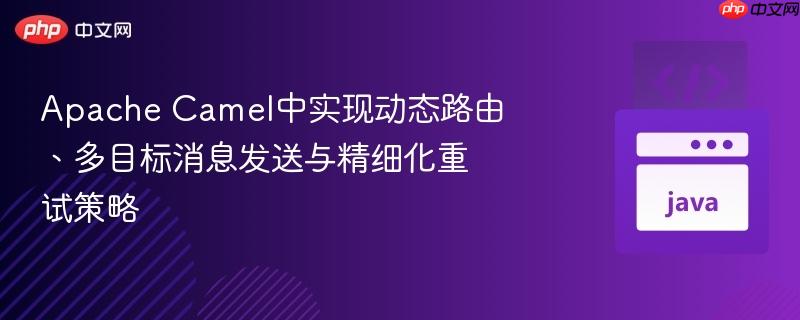
本文深入探讨了在apache camel中处理复杂消息路由、动态配置管理以及多目标消息发送的策略。我们将重点关注如何利用camel的eip(企业集成模式)来应对“一进多出”的数据流挑战,实现基于配置的动态路由、消息过滤与重映射,并设计出仅针对发送环节的精细化重试机制,同时兼顾动态端点配置与认证。
在现代集成场景中,处理从单一源接收的消息,并根据业务规则将其动态地分发到多个目标系统是一个常见需求。特别是在需要根据客户特定配置进行消息转换、过滤,并向不同客户的REST API发送消息时,Apache Camel提供了强大的EIP和组件来构建健壮、可扩展的解决方案。本教程将指导您如何利用Camel实现这一复杂流程,并专注于如何将重试逻辑精确地限定在消息发送环节。
面对一个消息需要根据其内容决定发送给哪个代理,然后该代理下的每个客户都可能需要接收消息(经过定制化处理和过滤),并且客户列表和其配置在运行时确定,Recipient List 和 Dynamic Router EIPs都是潜在的选项。
然而,对于本场景中“一个消息对应多个客户配置,每个客户独立处理并发送”的情况,一个更直接且灵活的EIP组合是 Splitter (拆分器)。
使用Splitter的优势: 通过在消息主体中准备一个包含所有待处理客户信息的列表,然后使用 Splitter EIP将这个列表拆分成单独的消息。每个拆分后的消息都代表一个客户的发送任务,从而可以独立进行后续的过滤、转换和发送,并且最重要的是,可以独立地进行重试。
当一个原始消息(例如 RemappedMessage)需要与多个客户配置(CustomerConfig 列表)一起流转时,如何有效地传递这些相关数据是关键。由于Camel的消息主体(Body)通常只包含一个对象,我们需要一种机制将 RemappedMessage 和每个 CustomerConfig 关联起来。
推荐的方法是创建一个包含这些相关数据的复合对象,并将其作为消息主体传递。
推荐的数据结构:
示例:准备Splitter输入
在 CustomerConfigRetrieverBean 中,您将接收到 RemappedMessage。根据此消息,检索所有相关的 CustomerConfig 列表。然后,为每个 CustomerConfig 创建一个包含 (CustomerConfig, RemappedMessage) 的元组,并将这些元组汇集成一个 List 作为该Bean的返回。
// 假设 CustomerConfigRetrieverBean 接收 RemappedMessage 作为输入
public class CustomerConfigRetrieverBean {
public List<ImmutablePair<CustomerConfig, RemappedMessage>> retrieveAndCombine(RemappedMessage remappedMessage) {
// 根据 remappedMessage 中的 agentId 获取所有 CustomerConfig
List<CustomerConfig> customerConfigs = retrieveCustomerConfigsByAgentId(remappedMessage.getAgentId());
List<ImmutablePair<CustomerConfig, RemappedMessage>> combinedList = new ArrayList<>();
for (CustomerConfig config : customerConfigs) {
// 为每个客户配置创建一个 ImmutablePair,将其与原始的 remappedMessage 关联
combinedList.add(ImmutablePair.of(config, remappedMessage));
}
return combinedList; // 这个列表将作为 Splitter 的输入
}
// 模拟方法,实际应从配置源获取
private List<CustomerConfig> retrieveCustomerConfigsByAgentId(String agentId) {
// ... 实现配置获取逻辑 ...
return Arrays.asList(
new CustomerConfig("customer1", "http://api.customer1.com/data", "oauth_url_1", "client_id_1", "client_secret_1", "fieldA,fieldB"),
new CustomerConfig("customer2", "http://api.customer2.com/data", "oauth_url_2", "client_id_2", "client_secret_2", "fieldC")
);
}
}Camel的HTTP组件支持通过消息头(Headers)动态配置请求的URL、认证信息等。这使得在 Splitter 内部为每个客户独立设置发送目标成为可能。
动态URL (CamelHttpUri): 您可以通过设置 CamelHttpUri 消息头来指定HTTP请求的目标URL。Camel的 toD() (Dynamic To) EIP会利用此头信息。
认证信息 (Authorization Header): 对于OAuth或Basic认证,您需要计算相应的认证字符串并将其设置为 Authorization 消息头。
示例:在Splitter内部设置动态头
// 假设消息体现在是一个 ImmutablePair<CustomerConfig, RemappedMessage>
.setHeader("Authorization", simple("Bearer ${body.left.oauthToken}")) // 假设 CustomerConfig 中有获取到的OAuth Token
// 或者对于 Basic Auth:
// .setHeader("Authorization", simple("Basic ${body.left.base64EncodedCredentials}"))
// 设置目标URI
.setHeader(Exchange.HTTP_URI, simple("${body.left.targetUrl}")) // 使用 CustomerConfig 中的 targetUrl请注意,OAuth Token通常需要通过一个单独的请求获取。您可以在发送消息之前,在 Splitter 内部的某个Bean或处理器中执行OAuth流程,并将获取到的Token添加到消息头或Exchange属性中。
// 假设 CustomerConfig 包含 OAuth 相关的URL和凭据
public class OAuthTokenRetrieverBean {
public void retrieveToken(@Body ImmutablePair<CustomerConfig, RemappedMessage> pair, @Headers Map<String, Object> headers) {
CustomerConfig config = pair.getLeft();
// 实际的OAuth请求逻辑
String oauthToken = performOAuthRequest(config.getOauthUrl(), config.getClientId(), config.getClientSecret());
headers.put("Authorization", "Bearer " + oauthToken);
}
private String performOAuthRequest(String oauthUrl, String clientId, String clientSecret) {
// ... 实现 OAuth 客户端逻辑,例如使用 HttpClient ...
return "mock_oauth_token"; // 模拟返回
}
}使用 Splitter EIP的另一个重要优势是它天然地支持对每个拆分后的消息(即每个客户的发送任务)进行独立的错误处理和重试。
通过将发送逻辑封装在 Splitter 内部,您可以为 Splitter 块配置一个 errorHandler 或 onException 策略,使其仅对发送失败的子消息进行重试,而不会影响到消息接收、配置检索等上游步骤。
示例:结合Splitter和错误处理
from("activemq:queue:" + appConfig.getQueueName())
.bean(IncomingMessageConverter.class) // 转换为 RemappedMessage
.bean(UserIdValidator.class) // 验证用户ID
.bean(CustomerConfigRetrieverBean.class) // 返回 List<ImmutablePair<CustomerConfig, RemappedMessage>>
.split(body()) // 拆分列表,每个元素成为一个新的Exchange
.parallelProcessing() // 可选:并行处理每个客户的发送任务
.errorHandler(deadLetterChannel("activemq:queue:dlq").maximumRedeliveries(3).redeliveryDelay(2000)) // 为每个拆分消息配置重试
.bean(EndpointFieldsTailor.class) // 根据 CustomerConfig 裁剪消息字段
.bean(OAuthTokenRetrieverBean.class) // 获取OAuth Token并设置Authorization头
.filter(simple("${body.left.filterCriteria.matches(${body.right.messageContent})}")) // 根据客户条件过滤消息
.setHeader(Exchange.HTTP_URI, simple("${body.left.targetUrl}")) // 设置目标URL
.toD("http://dummyhost?throwExceptionOnFailure=false") // 使用 toD 动态发送,并允许失败继续
.endFilter()
.end() // 结束 Splitter EIP
.log("所有客户消息处理完毕");在上述示例中:
结合上述讨论,一个完整的Camel路由可能如下所示:
import org.apache.camel.Exchange;
import org.apache.camel.builder.RouteBuilder;
import org.apache.commons.lang3.tuple.ImmutablePair;
import java.util.ArrayList;
import java.util.Arrays;
import java.util.List;
import java.util.Map;
// 假设的配置类和消息类
class AppConfig {
String getQueueName() { return "myQueue"; }
}
class RemappedMessage {
String agentId;
String messageContent;
// ... 其他字段
public RemappedMessage(String agentId, String messageContent) {
this.agentId = agentId;
this.messageContent = messageContent;
}
public String getAgentId() { return agentId; }
public String getMessageContent() { return messageContent; }
}
class CustomerConfig {
String customerId;
String targetUrl;
String oauthUrl;
String clientId;
String clientSecret;
String requiredFields; // 逗号分隔的字段列表
String filterCriteria; // 过滤条件,例如一个正则表达式或简单表达式
public CustomerConfig(String customerId, String targetUrl, String oauthUrl, String clientId, String clientSecret, String requiredFields) {
this.customerId = customerId;
this.targetUrl = targetUrl;
this.oauthUrl = oauthUrl;
this.clientId = clientId;
this.clientSecret = clientSecret;
this.requiredFields = requiredFields;
this.filterCriteria = ".*"; // 默认不过滤
}
// Getters
public String getTargetUrl() { return targetUrl; }
public String getOauthUrl() { return oauthUrl; }
public String getClientId() { return clientId; }
public String getClientSecret() { return clientSecret; }
public String getRequiredFields() { return requiredFields; }
public String getFilterCriteria() { return filterCriteria; }
public void setFilterCriteria(String filterCriteria) { this.filterCriteria = filterCriteria; }
}
// 模拟的Bean
class IncomingMessageConverter {
public RemappedMessage convert(String rawMessage) {
System.out.println("Converting incoming message: " + rawMessage);
return new RemappedMessage("agentX", "original_content_with_fieldA_fieldB_fieldC");
}
}
class UserIdValidator {
public void validate(RemappedMessage message) {
System.out.println("Validating user ID for agent: " + message.getAgentId());
// 模拟验证逻辑,如果失败可以抛出异常
}
}
// CustomerConfigRetrieverBean 见上文
class EndpointFieldsTailor {
public ImmutablePair<CustomerConfig, RemappedMessage> tailor(ImmutablePair<CustomerConfig, RemappedMessage> pair) {
CustomerConfig config = pair.getLeft();
RemappedMessage message = pair.getRight();
System.out.println("Tailoring fields for customer " + config.customerId + ". Required: " + config.getRequiredFields());
// 根据 config.getRequiredFields() 修改 message 的内容
// 这里只是模拟,实际可能涉及 JSON/XML 解析和字段操作
String tailoredContent = "tailored_content_for_" + config.customerId + "_with_" + config.getRequiredFields();
return ImmutablePair.of(config, new RemappedMessage(message.getAgentId(), tailoredContent));
}
}
// OAuthTokenRetrieverBean 见上文
public class DynamicRoutingTutorialRoute extends RouteBuilder {
private final AppConfig appConfig;
public DynamicRoutingTutorialRoute(AppConfig appConfig) {
this.appConfig = appConfig;
}
@Override
public void configure() throws Exception {
// 全局错误处理,捕获未被特定路由块处理的异常
onException(Exception.class)
.maximumRedeliveries(0) // 不重试
.handled(true)
.log("全局错误捕获: ${exception.message}");
from("activemq:queue:" + appConfig.getQueueName())
.routeId("mainProcessingRoute")
.log("接收到来自队列的消息")
.bean(IncomingMessageConverter.class)
.bean(UserIdValidator.class)
.bean(CustomerConfigRetrieverBean.class) // 返回 List<ImmutablePair<CustomerConfig, RemappedMessage>>
.split(body()).parallelProcessing() // 拆分列表,并行处理
.setHeader("customerId", simple("${body.left.customerId}")) // 将客户ID提升到Header,便于日志和跟踪
.log("开始处理客户: ${header.customerId}")
// 为每个拆分消息配置局部重试
.errorHandler(deadLetterChannel("activemq:queue:customerDlq")
.maximumRedeliveries(3)
.redeliveryDelay(2000)
.logStackTrace(true)
.onRedelivery(exchange -> {
System.out.println("Retrying send for customer " + exchange.getIn().getHeader("customerId") + " (attempt " + exchange.getProperty(Exchange.REDELIVERY_COUNTER) + ")");
}))
.bean(EndpointFieldsTailor.class) // 根据 CustomerConfig 裁剪消息字段
.bean(OAuthTokenRetrieverBean.class) // 获取OAuth Token并设置Authorization头
.filter(simple("${body.right.messageContent} contains '${body.left.filterCriteria}'")) // 根据客户条件过滤消息
.log("客户 ${header.customerId} 满足过滤条件,准备发送")
.setHeader(Exchange.HTTP_URI, simple("${body.left.targetUrl}")) // 设置目标URL
.setHeader(Exchange.HTTP_METHOD, constant("POST")) // 设置HTTP方法
.setBody(simple("${body.right.messageContent}")) // 将 RemappedMessage 的内容作为HTTP Body
.toD("http://dummyhost?throwExceptionOnFailure=true") // 使用 toD 动态发送,失败则抛出异常触发重试
.log("成功发送消息给客户: ${header.customerId}, 响应: ${body}")
.endFilter()
.log("客户 ${header.customerId} 处理完成 (可能已过滤或发送)")
.end() // 结束 Splitter EIP
.log("所有客户消息处理完毕,主路由结束");
}
}通过巧妙地结合Apache Camel的 Splitter EIP,以及利用消息头进行动态端点配置和认证,我们能够构建一个高度灵活且健壮的消息处理系统。这种方法不仅解决了“一进多出”的数据流挑战,还实现了对消息发送环节的精细化重试控制,从而大大提高了系统的可靠性和可维护性。理解并运用这些EIP是构建复杂集成解决方案的关键。
以上就是Apache Camel中实现动态路由、多目标消息发送与精细化重试策略的详细内容,更多请关注php中文网其它相关文章!

Copyright 2014-2025 https://www.php.cn/ All Rights Reserved | php.cn | 湘ICP备2023035733号